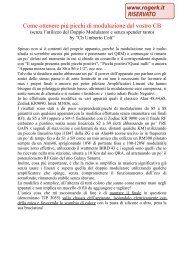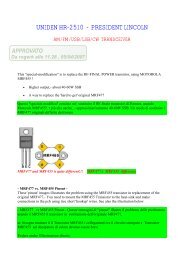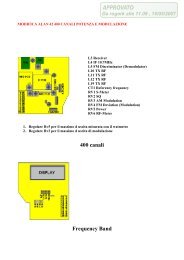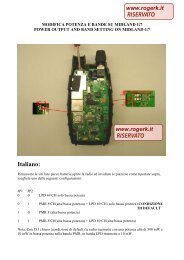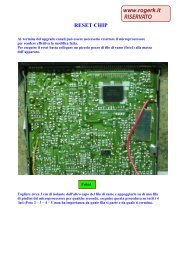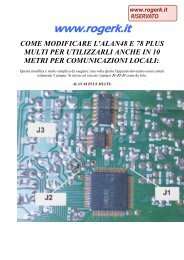Modifications for the ICOM - RogerK
Modifications for the ICOM - RogerK
Modifications for the ICOM - RogerK
- No tags were found...
You also want an ePaper? Increase the reach of your titles
YUMPU automatically turns print PDFs into web optimized ePapers that Google loves.
AM wide...............(none)................ 6 KHz (CFW455IT)AM normal............ 2.8 KHz (FL-70)....... 2.8 KHz (CFJ455K5)SSB/CW/RTTY wide..... 2.8 KHz (FL-70)....... 6 KHz (CFW455IT)SSB/CW/RTTY normal... 2.3 KHz (FL-30)....... 2.8 KHz (CFJ455K5)At first glance, one might think that it would have been more logical to use both 2.8 KHz filters in <strong>the</strong> SSB "wide" position(similar to <strong>the</strong> AM "normal" position), ra<strong>the</strong>r than a 2.8 KHz filter followed by a 6 KHz filter. (Since <strong>the</strong> narrower of <strong>the</strong> filters in<strong>the</strong> IF chain really determines <strong>the</strong> overall bandwidth, <strong>the</strong> 6 KHz filter is actually doing nothing.) However, if things had been setup this way, replacement of <strong>the</strong> 2.8 KHz 3rd IF filter with <strong>the</strong> optional FL-44A 2.4 KHz high grade crystal filter would haverestricted <strong>the</strong> SSB "wide" bandwidth to 2.4 KHz. The SSB "wide" and "normal" bandwidths would <strong>the</strong>n have been virtuallyidentical.Observe that <strong>the</strong> installation of <strong>the</strong> FL-44A does in fact reduce <strong>the</strong> AM "normal" bandwidth from 2.8 KHz to 2.4 KHz. Here's how<strong>the</strong> filter chart would look <strong>for</strong> an R71A with both <strong>the</strong> optional FL-44A and <strong>the</strong> optional FL-32 CW narrow filter installed:2nd IF3rd IFAM wide.................. (none)................ 6 KHz (CFW455IT)AM normal................ 2.8 KHz (FL-70)....... 2.4 KHz (FL-44A)SSB/CW/RTTY wide......... 2.8 KHz (FL-70)....... 6 KHz (CFW455IT)SSB/CW/RTTY normal....... 2.3 KHz (FL-30)....... 2.4 KHz (FL-44A)Narrow-all modes......... 500 Hz (FL-32)....... 2.4 KHz (FL-44A)Having <strong>the</strong> razor sharp 2.4 KHz bandwidth of <strong>the</strong> FL-44A accessible in <strong>the</strong> AM mode can sometimes be great <strong>for</strong> critical DXing,but AM audio at that bandwidth does lack sufficient fidelity <strong>for</strong> com<strong>for</strong>table listening.With some minor rewiring of <strong>the</strong> filter selection hardware, <strong>the</strong> 2.8 KHz AM bandwidth can be restored in "FL-44A"-equipped R71Areceivers. This is done by making <strong>the</strong> AM "normal" setting select <strong>the</strong> same 2.8 KHz (FL-70) / 6 KHz (CFW455IT) filter pair whichis used in <strong>the</strong> SSB "wide" setting. For experimental purposes, I had temporarily configured my R71 to select this filter pair in <strong>the</strong>AM "wide" setting in order to make direct receive fidelity and skirt selectivity comparisons against <strong>the</strong> 2.4 KHz AM "normal"setting.My findings revealed that with <strong>the</strong> receiver tuned directly to a broadcast station, both bandwidths produced very similar soundingaudio without much fidelity. But by tuning <strong>the</strong> R71A's main tuning dial 1.5 KHz away from <strong>the</strong> AM carrier frequency, <strong>the</strong> 2.8 KHzfilter passed <strong>the</strong> carrier and enough of one of its sidebands to provide halfway decent fidelity. (It was noticeably less than <strong>the</strong> 6KHz bandwidth, but still quite usable.) The same trick was also tried with <strong>the</strong> narrower, 2.4 KHz passband by tuning <strong>the</strong> maindial 1 KHz off frequency; but even <strong>the</strong>n <strong>the</strong> fidelity was still too restricted <strong>for</strong> com<strong>for</strong>table listening.Since <strong>the</strong> 2.8 KHz bandwidth seemed to isolate noisy AM signals just as well as <strong>the</strong> 2.4 KHz setting in most of my tests, I hadinitially considered replacing <strong>the</strong> 2.4 KHz setting with 2.8 KHz in order to take advantage of <strong>the</strong> additional fidelity. However, I didencounter some relatively rare instances when trying to tune in a weak AM station adjacent to a strong local broadcaster where<strong>the</strong> 2.8 KHz/6 KHz filter pair allowed some odd residual noise from <strong>the</strong> strong adjacent signal to become embedded in <strong>the</strong>desired signal. The noise was not <strong>the</strong>re when using <strong>the</strong> 2.8 KHz/2.4 KHz filter pair. This revelation led me instead to devise away of making both bandwidths available in <strong>the</strong> AM mode (in addition to <strong>the</strong> 6 KHz bandwidth).TECHNICAL DISCUSSION:For <strong>the</strong> following technical discussion of <strong>the</strong> IF filter selection circuit of <strong>the</strong> R71, you may wish to refer to your schematic diagramor service manual. The filter select IC is IC3 on <strong>the</strong> main PC board. It has three input pins (pins 9, 10, and 11); <strong>the</strong> logic state ofwhich are determined by <strong>the</strong> operating mode (AM, FM, SSB/CW/RTTY) and by <strong>the</strong> position of <strong>the</strong> "wide" and "narrow" filterswitches on <strong>the</strong> front panel. The configuration of <strong>the</strong>se settings determines which IC output pin goes high. (Output pins are pins1, 2, 4, 5, 12, 14 and 15.) Diodes connected from <strong>the</strong> output pins to <strong>the</strong> various filters determine which filters are activated byeach specific mode-bandwidth combination. There are two output pins (pins 1 and 4) which are only activated in <strong>the</strong> FM mode.These outputs are unused (not connected to anything) since <strong>the</strong> optional FM board has its own IF filter which is automaticallyselected in <strong>the</strong> FM mode.The following table from <strong>the</strong> service manual shows <strong>the</strong> input-output relationship of IC-3:INPUT PINMODE 9 10 11 OUTPUT PINSSB/CW/RTTY normal L L H 14SSB/CW/RTTY wide H L H 5**SSB/CW/RTTY narrow* L H H 12AM normal L H L 15AM wide H H L 2AM narrow* L H H 12FM normal H L L 1FM wide H L L 1FM narrow* H H H 4* assuming optional filter switch (S1 on main PC board) is ON.** this output was incorrectly listed as pin 3 in <strong>the</strong>service manual.




